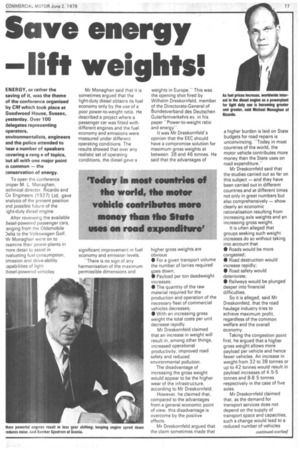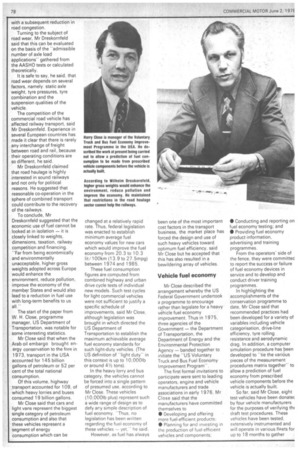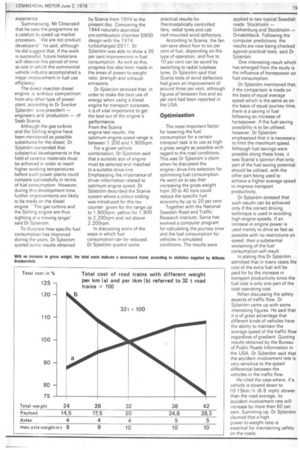Save energy lift weights!
Page 79

Page 80

Page 81

If you've noticed an error in this article please click here to report it so we can fix it.
ENERGY, or rather the saving of it, was the theme of the conference organised by CM which took place at Goodwood House, Sussex, yesterday. Over 100 delegates representing operators,
environmentalists, engineers end the police attended to bear a number of Speakers covering a rang e of topics, but all with one major point In common — the conservation of energy.
To open the conference Droper M. L. Monaghan, :echnical director, Ricardo and Co Engineers (1927) Ltd, gave analysis of the present position n d possible future of the ight-duty diesel engine.
After reviewing the available liesel-powered passenger cars, .anging from the Oldsmobile Delta to the Volkswagen Golf, VIr Monaghan went on to ,ixamine their power-plants in -nore detail to assist in Dvaluating fuel consumption, Dmission and drive-ability :apabilities of light Jiesel-powered vehicles.
Mr Monaghan said that it is sometimes argued that the light-duty diesel obtains its fuel economy only by the use of a poor power-to-weight ratio, He described a project where a passenger car was fitted with different engines and the fuel economy and emissions were measured under different operating conditions. The results showed that over any realistic set of operating conditions, the diesel gave a significant improvement in fuel economy and emission levels.
"There is no sign of any harmonisation of the maximum permissible dimensions and weights in Europe." This was the opening shot fired by Wilhelm Dreskornfeld, member of the Directorate-General of Bundesverband des Deutschen Guterfernverkehrs ev, in his paper ''Power-to-weight ratio and energy''.
It was Mr Dreskornfeld's opinion that the EEC should have a compromise solution for maximum gross weights at between 38 and 46 tonnes. He said that the advantages of higher gross weights are obvious • For a given transport volume the number of lorries required goes down; • Payload per ton deadweight increases; • The quantity of the raw material required for the production and operation of the necessary fleet of commercial vehicles decreases; • With an increasing gross weight the total costs per unit decrease rapidly.
Mr Dreskornfeld claimed that an increase in weight will result in, among other things, increased operational productivity, improved road safety and reduced environmental pollution.
The disadvantage of increasing the gross weight would appear to be the higher wear of the infrastructure, according to Mr Dreskornfeld.
However, he claimed that, compared to the advantages from a general economic point of view, this disadvantage is overcome by the positive effects.
Mr Dreskornfeld argued that the claim sometimes made that a higher burden is laid on State budgets for road repairs is unconvincing. "Today in most countries of the world, the motor vehicle contributes more money than the State uses on road expenditure."
Mr Dreskornfeld said that the studies carried out so far on this subject — and they have been carried out in different countries and at different times not only in great numbers but also comprehensively — show clearly an economic rationalisation resulting from increasing axle weights and an increasing gross weight.
It is often alleged that groups seeking such weight increases do so without taking into account that: • Roads would be more congested; I Road destruction would increase rapidly; • Road safety would deteriorate; • Railways would be plunged deeper into financial difficulties.
So it is alleged, said Mr Dreskornfeld, that the road haulage industry tries to achieve maximum profit, regardless of the common welfare and the overall economy.
Taking the congestion point first, he argued that a higher gross weight allows more payload per vehicle and hence fewer vehicles. An increase in weight from 32 to 38 tonnes or up to 42 tonnes would result in payload increases of 4.5-5 tonnes and 8-8.5 tonnes -respectively in the case of five axles.
Mr Dreskornfeld claimed that, as the demand for transport services does not depend on the supply of transport space and capacities, such a change would lead to a reduced number of vehicles • with a subsequent reduction in road congestion.
Turning to the subject of road wear, Mr Dreskornfeld said that this can be evaluated on the basis of the -admissible number of axle load applications" gathered from the AASHO tests or calculated theoretically.
It is safe to say, he said, that road wear depends on several factors, namely static axle weight, tyre pressures, tyre combination and the suspension qualities of the vehicle.
The competition of the commercial road vehicle has affected railway transport, said Mr Dreskornfeld. Experience in several European countries has made it clear that there is rarely any interchange of freight between road and rail, because their operating conditions are so different, he said.
Mr Dreskornfeld claimed that road haulage is highly interested in sound railways and not only for political reasons. He suggested that reasonable co-operation in the sphere of combined transport could contribute to the recovery of the railways.
To conclude, Mr
Dreskornfeld suggested that the economic use of fuel cannot be looked at in isolation — it is closely linked to weights, dimensions, taxation, railway competition and financing. "Far from being economically and environmentally unacceptable, higher gross weights adopted across Europe would enhance the environment, reduce pollution, improve the economy of the member States and would also lead to a reduction in fuel use with long-term benefits to us all.
The start of the paper from W. H. Close, programme manager, US Department of Transportation, was notable for some interesting statistics.
Mr Close said that when the Arab oil embargo brought energy conservation to the fore in 1973, transport in the USA accounted for 145 billion gallons of petroleum or 52 per cent of the total national consumption.
Of this volume, highway transport accounted for 109, of which heavy lorries and buses consumed 19 billion gallons.
Mr Close said that cars and light vans represent the biggest single category of petroleum consumption and also that these vehicles represent a segment of energy consumption which can be changed at a relatively rapid rate. Thus, federal legislation was enacted to establish minimum average fuel economy values for new cars which would improve the fuel economy from 20.3 to 10.3 lit,/ 100km (13.9 to 27.5mpg) between 1974 and 1985.
These fuel consumption figures are computed from combined highway and urban drive cycle tests of individual new models. Such test cycles for light commercial vehicles were not sufficient to justify a specific schedule of improvements, said Mr Close, although legislation was brought in which directed the US Department of Transportation to establish the maximum achievable average fuel economy standards for such light-duty vehicles. (The US definition of -light duty"' in this context is up to 10,000lb or around 41/2 tons).
In the heavy lorry and bus category, the vehicles cannot be forced into a single pattern of presumed use, according to Mr Close. These vehicles (10.000lb plus) represent such a wide range of design as to defy any simple description of fuel economy. -Thus, no legislation has been written regarding the fuel economy of these vehicles --yet,'" he said.
However, as fuel has always been one of the most important cost factors in the transport business, the market place has forced the design and use of such heavy vehicles toward optimum fuel efficiency, said Mr Close but he accepted that this has also resulted in a bewildering array of vehicles.
Vehicle fuel economy Mr Close described the arrangement whereby the US Federal Government undertook a programme to encourage rather than legislate for a heavy vehicle fuel economy improvement. Thus in 1975, three agencies of the Government — the Department of Transportation, the Department of Energy and the Environmental Protection Agency — banded together to initiate the -US Voluntary Truck and Bus Fuel Economy Improvement Program".
The first formal invitations to participate were sent to leading operators, engine and vehicle manufacturers and trade associations in early 1976 Mr Close said that the manufacturers have committed themselves to • Developing and offering • more fuel-efficient products: • Planning for and investing in the production of fuel efficient vehicles and components; • Conducting and reporting on fuel economy testing; and • Providing fuel economy product information, advertising and training programmes.
From the operators" side of the fence, they were committee to report the success or failure of fuel economy devices in service and to develop and conduct driver training programmes.
In highlighting the accomplishments of the conservation programme to date, Mr Close said that recommended practices had been developed for a variety of variables including vehicle categorisation, drive-line efficiency, tyre rolling . resistance and aerodynamic drag. In addition, a computer simulation procedure has been developed to "tie the various pieces of the measurement procedures matrix together to allow a prediction of fuel economy from prescribed vehicle components before the vehicle is actually built.
So far, said Mr Close, eight test vehicles have been donatec by four vehicle manufacturers for the purposes of verifying th( draft test procedures. These vehicles have been tested, extensively instrumented and will operate in various fleets for up to 18 months to gather experience.
Summarising, Mr Closeisaid that he sees the programme as a catalyst to speed up market processes. We are not product developers!'" he said, although he did suggest that, if the work is successful. future historians will observe this period of time as one in which the commercial vehicle industry accomplished a major improvement in fuel use efficiency_ The direct-injection diesel engine is without competition from any other type of power plant, according to Dr Sverker Sieistrom, vice-president — engineers and production — of Saab Scania.
Although the gas turbine and the Stirling engine have been mentioned as possible substitutes for the diesel, Dr SjastrOm contended that substantial developments in the field of ceramic materials must be achieved in order to reach higher working temperatures before such power plants could compete successfully in terms of fuel consumption. However, during this development time, further improvements are likely to be made on the diesel engine. "The gas turbine and the Stirling engine are thus sighting at a moving target" said Dr Sjostrom.
To illustrate how specific fuel consumption has improved during the years, Dr Sjostram quoted some results obtained by Scania from 1944 to the present day. Comparing the 1 944 naturally aspirated pre-combustion chamber D600 design with the,1974 turbocharged DS11, Dr Sjastrom was able to show a 35 per cent improvement in fuel consumption. As well as this, progress has also been made in the areas of power-to-weight ratio, strength and exhaust emissions.
Dr Sjostrom stressed that, in order to make the best use of energy when using a diesel engine for transport purposes, it is of vital importance to get the best out of the engine's performance.
From the Scania engine test results. the optimum engine speed range is between 1,200 and 1,900rpm. For a given vehicle combination, Dr SjOstrom said that a suitable size of engine must be selected and matched to a suitable drive-line. Emphasising the importance of driver information related to optimum engine speed, Dr SjOstrom described the Scania system where a colour coding was introduced for the rev counter green for the range up. to 1,900rpm, yellow for 1,900 to 2,200rpm and red above 2,20Orpm.
In discussing some of the ways in which fuel consumption can be reduced, Dr Sjostram quoted some practical results for thermostatically controlled fans, radial tyres and cab roof-mounted wind deflectors, According to Scania, the fan can save about four to six per cent of fuel, depending on the type of operation, and five to 10 per cent can be saved by switching to radial tubeless tyres. Dr SjostrOm said that Scania tests of wind deflectors had given an improvement of around three per cent, although figures of between five and six per cent had been reported in the USA
Optimisation
. The most important factor for lowering the fuel consumption for a certain transport task is to use as high a gross weight as possible with regard to the road conditions. This was Dr Sj5strOrn"s claim when he discussed the engine/drive-line selection for optimising fuel consumption. He went on to say that increasing the gross weight from 30 to 40 tons could reduce the specific fuel economy by up to 20 per cent.
Together with the National Swedish Road and Traffic Research Institute, Sania has evolved a computer. program for calculating the journey time and the fuel consumption for vehicles in simulated conditions. The results were
applied to two typical Swedish roads Stockholm — Gothenburg and Stockholm — Ornskoldsvik. Following the computer predictions, the results are now being checked against practical tests, said Dr Sjdstriim.
One interesting result which has emerged from the study is the influence of horsepower on fuel consumption.
Sjostrom mentioned that, if the comparison is made on the basis of equal average speed which is the same as on the basis of equal journey time, there is a saving in fuel following an increase of horsepower. If the fuel saving possibility is to be utilised, however, Dr Sjostrom emphasised that it is necessary to limit the maximum speed. Although fuel savings were possible along these lines, it was Scania's opinion that only part of the fuel saving potential should be utilised, with the other part being used to achieve a higher average speed to improve transport productivity.
Dr SjOstrorn stressed that such results can be achieved only if the correct driving technique is used in avoiding high engine speeds. If an increase in engine power is used merely to drive as fast as possible with no restrictions on speed, then a substantial worsening of the fuel consumption will result.
In stating this Dr SjOstrom admitted that in many cases the cost of the extra fuel will be paid for by the increase in transport productivity since the fuel cost is only one part of the total operating cost.
When discussing the safety aspects of traffic flow, Dr Sjostrorn came up with some interesting figures. He said that it is of great advantage that different kinds of vehicles have the ability to maintain the average speed of the traffic flow regardless of gradient. Quoting results obtained by the Bureau of Public Roads Information in the USA, Dr Sjastrom said that the accident involvement rate is very sensitive to the speed differential between the vehicles in the traffic flow.
He cited the case where, if a vehicle is slowed down to 10-15km/h (6-9 mph) slower than the road average, its accident involvement rate will increase by more than 60 per cent. Summing up, Dr Sjostram claimed that a high power-to-weight ratio is essential for maintaining safety on the roads








































































































































